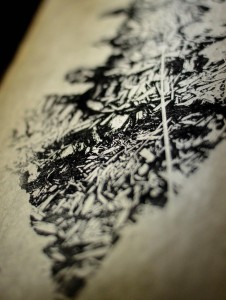By Geo Gomez
gomezgeo@grinnell.edu
The recent Smith Gallery exhibition, “For More,” was a week-long, collaborative show created by seniors Andy Lange, Caleb Neubauer, Clint Williamson and Vadim Fainberg, who is Business Manager for the S&B. The pieces vary in medium and setup but are characterized by fragmentation and repetition.

Williamson’s piece involves a looping movie clip and a live performance, culminating in a second loop, unique from the first clip.
“There are essentially three parts to the piece. They speak in a narrative,” Williamson said.
The first piece, a clip from the movie El Mariachi, portrays a man carrying a guitar case up the stairs. The clip repeats itself as the man reaches the top of the stairs, looping infinitely. Through headphones, the viewer hears the endless clatter of rushed footsteps again and again.
Williamson performed the second piece in the basement of the JRC. He performed an auditory piece related to his third piece in the exhibition, then entered an elevator and left.
“The performance was centered around recent political events such as the re-election of Barack Obama. People were preparing for the end of the world,” Williamson said.
Lastly, Williamson replaced his first piece with a self-edited video clip of the audio track. The video’s neon tint obscured the shapes in the video and in the background, an altered track of the house music from the second performance serves as the soundtrack. The viewer is offered an obscured view of the process of production, a behind-the-scenes look that does not reveal what is truly going on. Perhaps this was the aspect that was meant to parallel the election—the flurry of behind the scenes politicking, the infamous mudslinging of each campaign obscuring the real issues.
Neubauer’s piece “Ooraloo II” was a brief animation comprised of a series of charcoal drawings depicting coastal scenes. Each drawing was black and white and offered different scenes of the dark, ominous ocean.
The scenes are all dutifully illustrated. In one scene, Neubauer captures the perching of seagulls on a rock, their wing-strokes pulsing through the air. As soon as they land, the viewer is immediately transported to another scene. All the while, an eerie soundtrack accompanies the piece.
“The drawings were all done in the order you see them, so I drew one drawing, listened to the next part of the song, and that’s how I progressed through the series. The music framed the pace of the film,” Neubauer said.
At the end, the body of a man washes ashore to slump onto the beach. He seems to emerge from the murky depths of the water itself, and the title of the piece appears over the screen, along with a website connected with Neubauer’s art, http://tinyurl.com/pelican-ep, where you can follow the continuation of the project.
Lange’s piece “Rising Tide” is a series of slowly moving geometric shapes that overlap one another and vary in transparency and color. The movements of the shapes all move gradually with deliberate momentum.
“My earlier work was much more static, like boxes made of thin lines, and I think it was a lot more constructed, whereas these have a lot more movement, almost like an ambient, ephemeral feel,” Lange said.
The slow overlap of colors changes the composition in a seemingly natural progression from one phase to the next. The blocks interact with each other not as simple forms but almost like entities of their own, shifting and transforming themselves.
“The piece ended up being about patience and anticipation. The orange field coming over gently and increasing how much it comes over and then going away reminded me of a rising tide,” Lange said.
Fainberg’s piece is a large woodcut depicting a spinal column. Suspended above eye level, the viewer must look up to see the piece illuminated by a light source directly behind it, bestowing it a nearly mythic glow.
“Generally, the way I like to treat my prints isn’t as editions, but single pieces that are objects in some way,” Fainberg said. “There’s always some type of dialogue between the image and the object it’s on.”
The wood cut is actually three separate prints, as shown by gaps between two sections of the spinal cord. The bony pieces of the spine are separated by a gap like landscapes separated by continental drifts. Fainberg’s piece does not portray the entirety of the body it surely belongs to, but only provides a fragment of the whole; it seems like a relic recovered from another time. Fainberg transforms this piece of anatomy into a totem pole that resonates with veneration.
“I was playing with the ideas of idols and relics. The viewer literally has to look up and it’s a larger than life image,” Fainberg said.
Williamson helped explain the connecting thread between the four pieces.
“The show asks the viewer to take the pieces as fragments and put it in the context of the works around it,” Williamson said.
“For More” engages the viewer in an almost archaeological expedition to make sense of these fragments in the context of the show. Each piece showcases a unique artistic intent, and as a collection, questions how exactly pieces become a whole and what a beginning means to an end.




























































